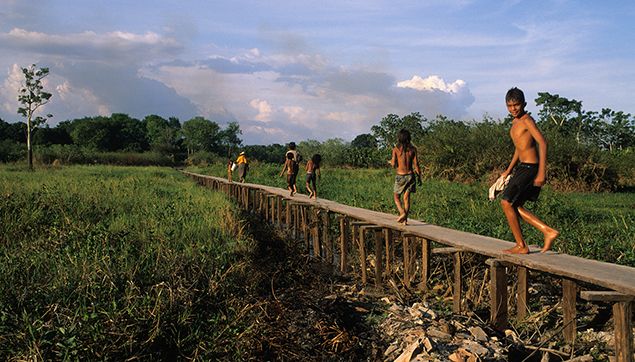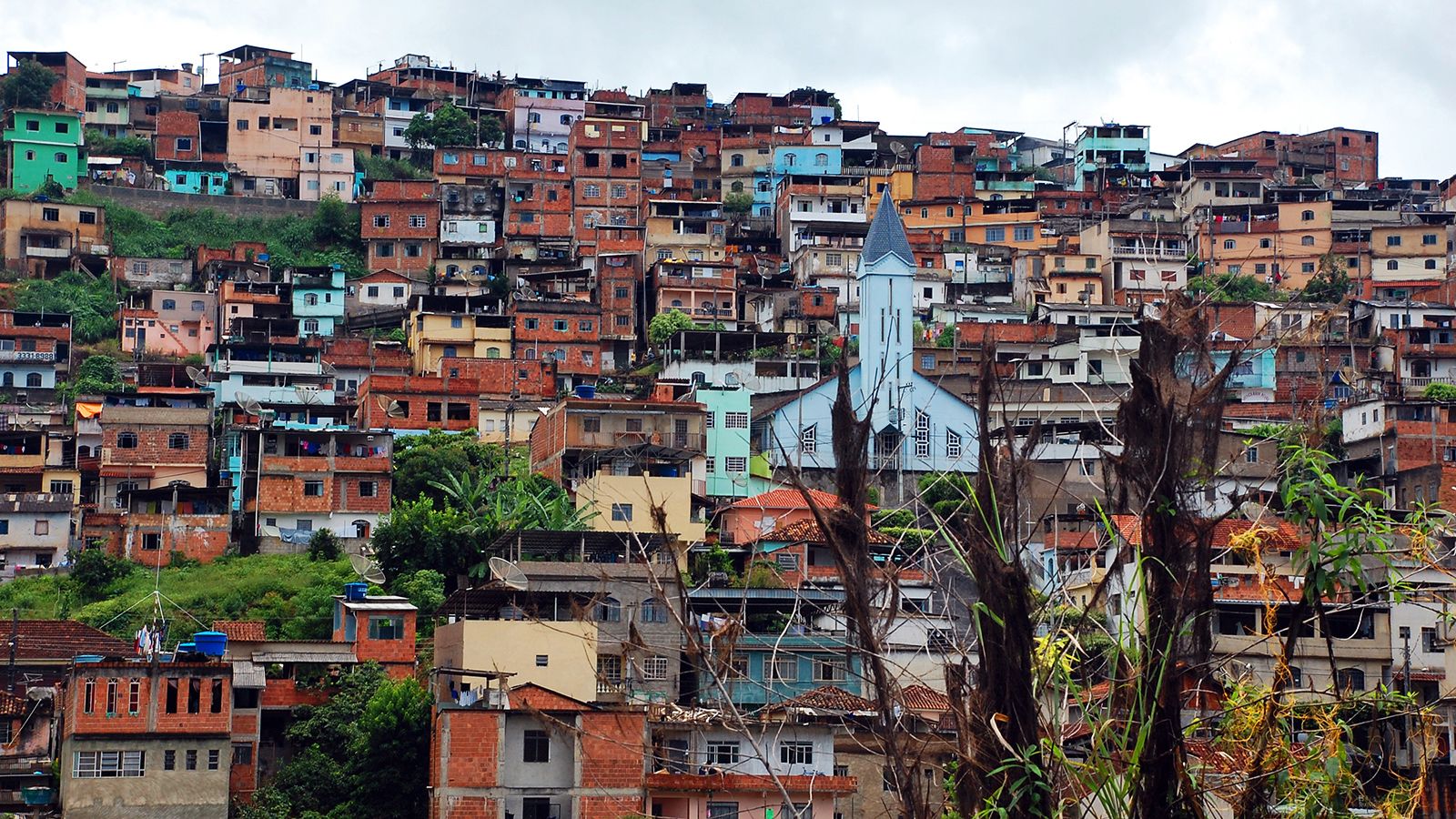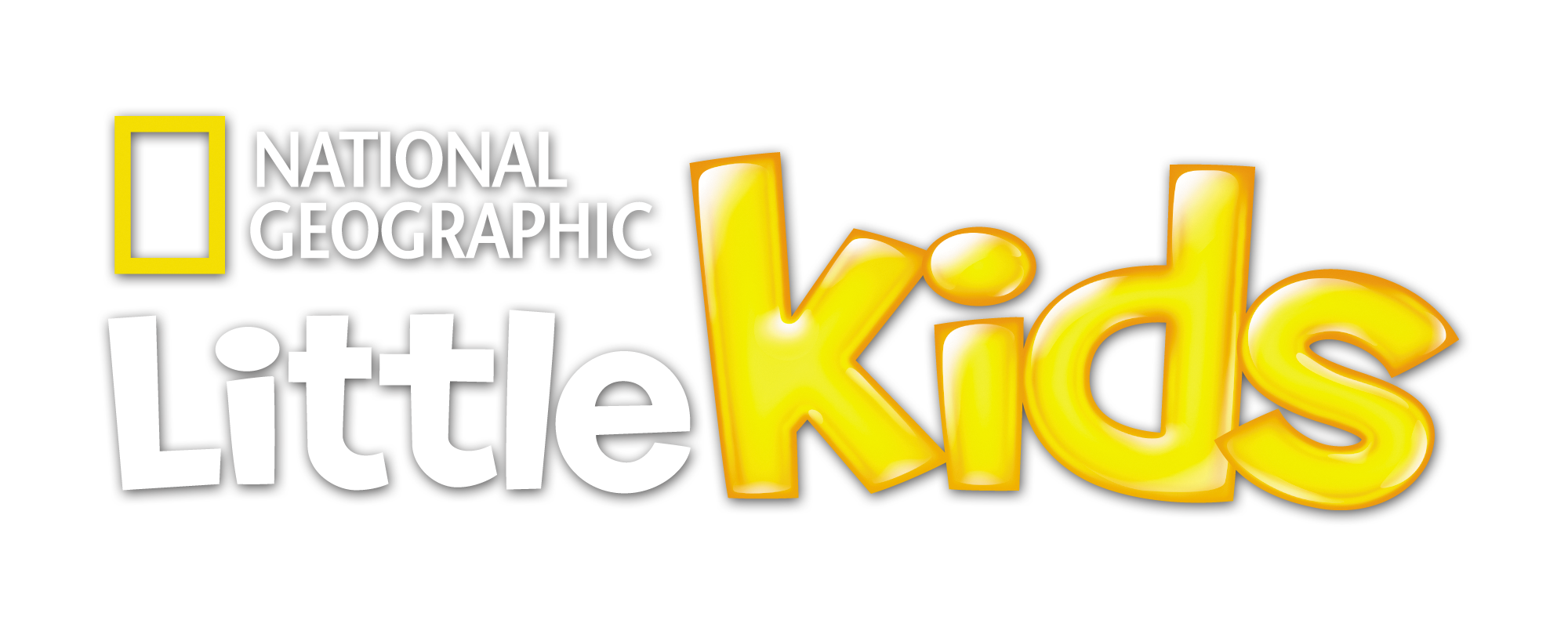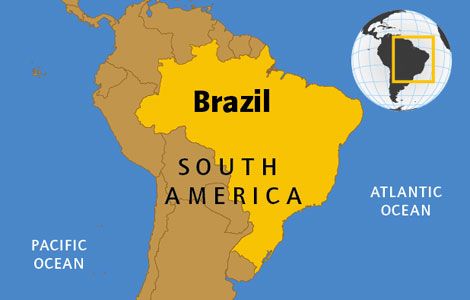Brazil facts: discover this super-cool country!
From Rio de Janeiro to the Amazon rainforest!
Join us, gang, as we set out on a South American adventure to this colourful, cultural country in our Brazil facts!

Brazil facts
OFFICIAL NAME: Federal Republic of Brazil
FORM OF GOVERNMENT: Democratic federal republic
CAPITAL: Brasilia
POPULATION: 183,888,841
OFFICIAL LANGUAGE: Portuguese
MONEY: Real
AREA: 3,286,470 square miles (8,511,965 square kilometers)
MAJOR MOUNTAIN RANGES: Serra do Mar, Serra do Espinhaço
MAJOR RIVERS: Amazon, São Francisco, Paraná, Tocantin
FLAG:

Brazil’s geography
Brazil is the largest country in South America and the fifth largest nation in the world. It forms an enormous triangle on the eastern side of the continent with a 7,400km coastline along the Atlantic Ocean. It has borders with every South American country except Chile and Ecuador.
The Brazilian landscape is very varied. It is most well known for its dense forests, including the Amazon, the world’s largest rainforest, in the north. But there are also dry grasslands (called pampas), rugged hills, pine forests, sprawling wetlands, immense plateaus (areas of level high ground) and a long coastal plain.

Northern Brazil is dominated by the Amazon River and the jungles that surround it. The Amazon is not one river but a network of many hundreds of waterways. Its total length stretches 6,840km. Thousands of species live in the river, including the infamous piranha and the boto, or pink river dolphin.
Southeastern Brazil was once completely covered with dense forest. Now it is the country’s industrial capital, home to Brazil’s biggest cities: São Paulo and Rio de Janeiro. It covers only 11 percent of the country but 43 percent of the country’s population lives there.

Did you know that we have FREE downloadable primary resources about Brazil’s Awa tribe and Guarani tribe? Great for teachers, homeschoolers and parents alike!
Brazilian people & culture
Most Brazilians are descended from three ethnic groups: Amerindians, European settlers (mainly from Portugal) and Africans. Starting in the 19th century, waves of immigrants from Europe, the Middle East, and even Japan added to this mix. This diversity of people has created a rich religious, musical and culinary culture.

Brazilians are football crazy, and their country has produced some of the most popular players in the world! Brazil has won the FIFA World Cup finals five times, more than any other nation.
Brazil is also home to the world’s largest carnival – Rio Carnival! Each year, in the days leading up to Lent, around 2 million people take to the streets of Rio de Janeiro to enjoy music, dancing, elaborate costumes and parades.
 Carnival is one seriously cool, colourful celebration!
Carnival is one seriously cool, colourful celebration!
Brazil’s wildlife & nature
Brazil has the greatest variety of animals of any country in the world. It is home to 600 mammal species, 1,500 fish species, 1,600 bird species and an amazing 100,000 different types of insects. Brazil’s jungles are home to most of its animal life, but many unique species also live in the pampas and semidesert regions.
In the central-western part of Brazil sits a flat, swampy area called the Pantanal. This patchwork of flooded lagoons and small islands is the world’s largest wetland. Here live giant anacondas, huge guinea pig relatives called capybaras, and fierce South American alligators called caimans.

For thousands of years, people have been exploiting the jungles of Brazil. But since Europeans arrived about five centuries ago, forest destruction has become a major problem. Most of Brazil’s Atlantic rainforest is now gone, and huge tracts of the Amazon are disappearing every year. The government has established many national parks and refuges, but theses only cover around seven percent of the country.
 Sadly, deforestation means lots of Brazil’s amazing animals are losing their tree-top homes
Sadly, deforestation means lots of Brazil’s amazing animals are losing their tree-top homes
Brazilian government & economy
Brazil is a federal republic with a president, a National Congress, and a legal system. From 1888 until recently, the country struggled with democracy (where a government is decided by the population as a whole). But in 1985, the military government was peacefully removed, and by 1995, Brazil’s politics and economy had become fairly stable.
Brazil has many different soils and climates, so it can produce a great variety of crops. Its agricultural exports include sugarcane, latex, coffee, cocoa beans, cotton, soybeans, rice, and tropical fruits.
Brazil is also South America’s most industrial nation, producing chemicals, steel, aircraft, and cars.
 Brazil is also famous for its ‘favelas’ – slum settlements like this on the outskirts of cities
Brazil is also famous for its ‘favelas’ – slum settlements like this on the outskirts of cities
Brazilian history
Until recently, scientists thought Brazil was first settled by Asians about 10,000 years ago. But new evidence shows there were people living there at least 32,000 years ago. Some experts think they may have arrived from islands in the Pacific Ocean.
Brazil was added to the map of the world during the great European explorations in the late 15th century led by Portugal and Spain. When Europeans first reached the coast of Brazil, the country was home to about 30 million indigenous people, or Amerindians. Today, only about 300,000 remain, living primarily in Brazil’s remotest places.
Portugal established its first colony in Brazil in 1530. Colonists created sugarcane plantations along the coast and sent diamonds and gold back to Europe. Soon, people from West Africa were brought to Brazil to work as slaves. The discovery of large inland gold reserves brought thousands of people from the coasts and abroad to the interior of the country.
 Lots of slaves were brought from Africa to work on Brazil’s sugarcane plantations and in sugar mills
Lots of slaves were brought from Africa to work on Brazil’s sugarcane plantations and in sugar mills
In 1789, Brazilians tried to kick out their Portuguese rulers. The rebellion was soon put down, but it started a movement toward independence, which was successfully gained in 1822. Kings of Portuguese blood ruled until 1888, when military leaders and landowners expelled the king. This was also the year that slavery was abolished in Brazil.
Photos an illustrations: Bay in Rio de Janeiro, Brazil: Hans Magelssen, Dreamstime. Christ the Redeemer statue in Rio de Janeiro, Brazil: Steve Allen, Dreamstime. F in Brazil: Paura, Dreamstime. Amazon River: Jaysi, Dreamstime. Children crossing a footbridge: Carlos Mora, Dreamstime. People playing soccer on a beach: Lazyllama, Dreamstime. All other images Getty Images UK.
Words from kids.nationalgeographic.com.
Figures accurate at time of publication, January 2015.
What do you think of our Brazil facts? Let us know by leaving us a comment!
More Like Countries

Country Fact File: Peru!

Bahamas facts!

Bolivia facts: discover this incredible country!












LEAVE A COMMENT
THANK YOU
Your comment will be checked and approved shortly.
WELL DONE,
YOUR COMMENT
HAS BEEN ADDED!
COMMENTS
Hi ng kids I love the facts
cool
Cool
It is very good
This was very useful for school research project this was a very useful website
It’s good for facts
This is really good info!!!
Good info for projects
Hi
There is no things about landmarks on there
I'm not seing my topic but it is great
cool
i like it
this website is great!!!!!!!!!!!!!!!!!!
bad
cool
its bad
cool
cool
wow awesome facts
This is ok
I'm from Brazil!!!
Cool wow I learnt a lot
cool
WOWkktdf
Yo yo
cool soooooooooooooooooooooooooo helpful
best thing ever
Lollol
it really helps for my project
i really like this helpful info i bet i will come back soon
Fab!
lovelovelovelovelovelovelovelovelovelovelovelovleovelovelovelovelove lovelovelovelovelovelovelovelovelovelovelovelovelovelove
helps in doing homework thx
hey
helped with my homework thanks
nice
Amazing just a ausome!
COOL
Awesome
lol
Hi
michael strachan ########################################################################################################################################################################
No way
cool
very good but it can be better
epic
gosh
uieuygtjjhguhgbvghirguhghgtuhggurbrghbughbth
Nice
Nice
Love Brazil
uujjhu
nothing interesting
cool
YOLO
i love brazilllllll
briazl is cool
Thanks really helped with homework!
Lol awesome
this is so boring id rather po in my hand and clap, if you disagree then say bring it on! #HATERS#GUNNA#HATE #HATERS#BACK#OFF 8====D
TO GUST ME I SO AGREE!!
EPIC
JME
Boring
Oi rood boy shut up
AWESOME!
COOL, where is Christ the Redemmer?
UMMMMMMMMMMMMMM!!!!!!!!!!!!!!!!!!!!!!!!!!!!!!!!!!!!!!!!!!!!!!!!!!!!!!!!!!!!!!!!!!!!!!!1
OMG not only do I love Brazil but I also love this website. It tells us the interesting facts and everything is on. I had an exam and Brazil was one of the themes. I came here and surely all thanks to this web I passed ,woo. I definitely give this 11/10 and if any of you reading this that just went to the end I say read and find more about countries. KEEP UP THE GLORIOUS WORK PEEPS.
i like this website.
lol
i like brazil it is awsome my name is jeff
RONALDO
Love Brazil
Love Brazil
porrrrrrra
that helped so much!
lolololooololllolol
swwaw
jeff googd
my name is jeff
poooooooooop
LOVE IT
This really help with my reaserch for my Brazil project!!
Geee, thanks a lot NG kids! I was doing a small project on Brazil, and this really helped me a lot. Thanksa huge lot! I dont think my projects would be just as good as they are without these awesome facts off of this website! thanks. lol
this country is so awesome!!!!!!!!!!!!!!!!!!!!!!!!!!!!!!!!!!!!!!!
the website is amazing i love it
AMESOME
OMG thanks I learnt so much for my project
cool
awesome
Thanks for the info! You really helped with my homework
great website
Wow.Great Facts.So much help!!!
OMG! thanks great facts so much iformation
OMG!! I just loved reading about this amazing country. The country doesnt sound too bad and i was amazed to see the popularity of it. COOL!!
thanks used it for homework
what about the weathert
Thanks! This really helped me with my homework!
amazing!
Really cool
this really is cool
really helped with school work
best website ever
this page is good
This really helped me with my homework I got an a+ in it because it was so facinating
Olaf is quiet contrary because hes an animal and he looks very happy and jolly well good but he even has very nice friends
WOW! SOME AMAZING INFO.REALLY SICK.
i love brazillllllll
Wow this helped me loads with a school project!!!
thanks guys!
really helped!!! But I would like some more facts on the history.
Thx
Amazing!!I would like to visit the rainforest!
Cool
i love brazil so much guys lol ttyl guys !sim eu amo brazil lol im speaking portuguese
ohhh ahhhh
fabulous!!!!
Cool! I love Brazil!!!!!!!!! lol xx
CUSTOMIZE YOUR AVATAR